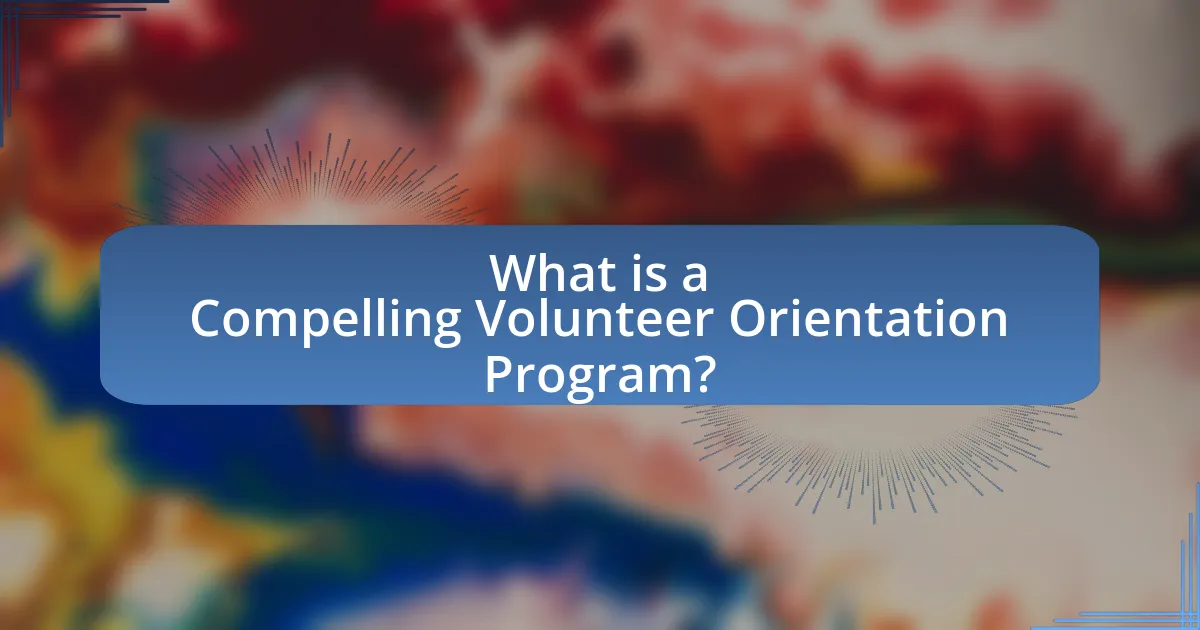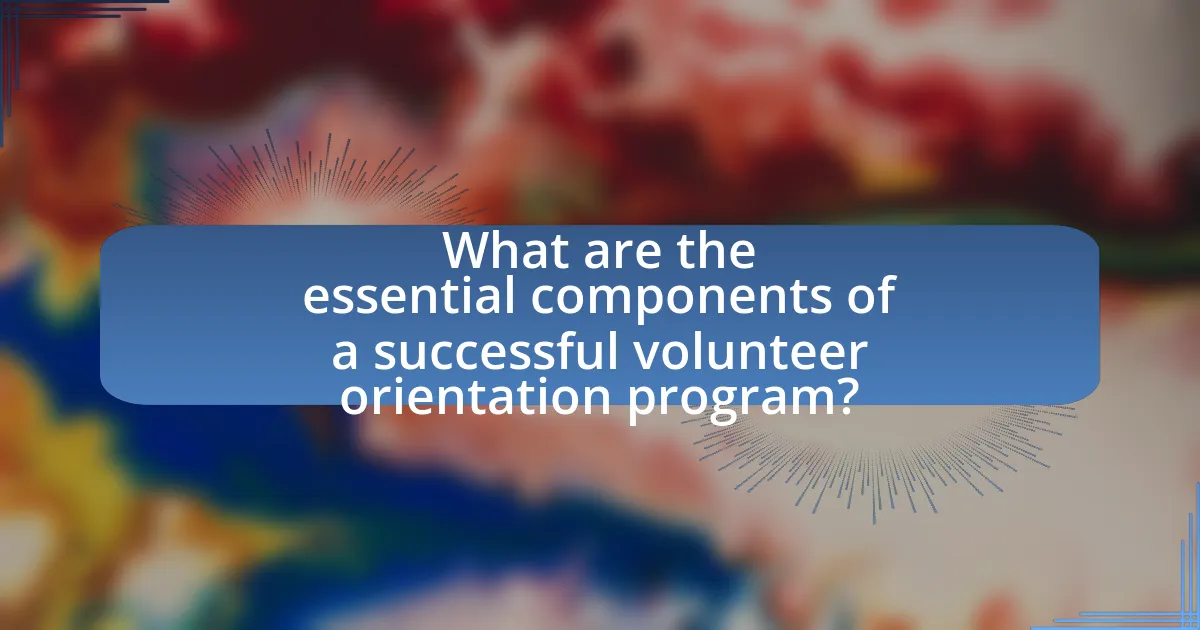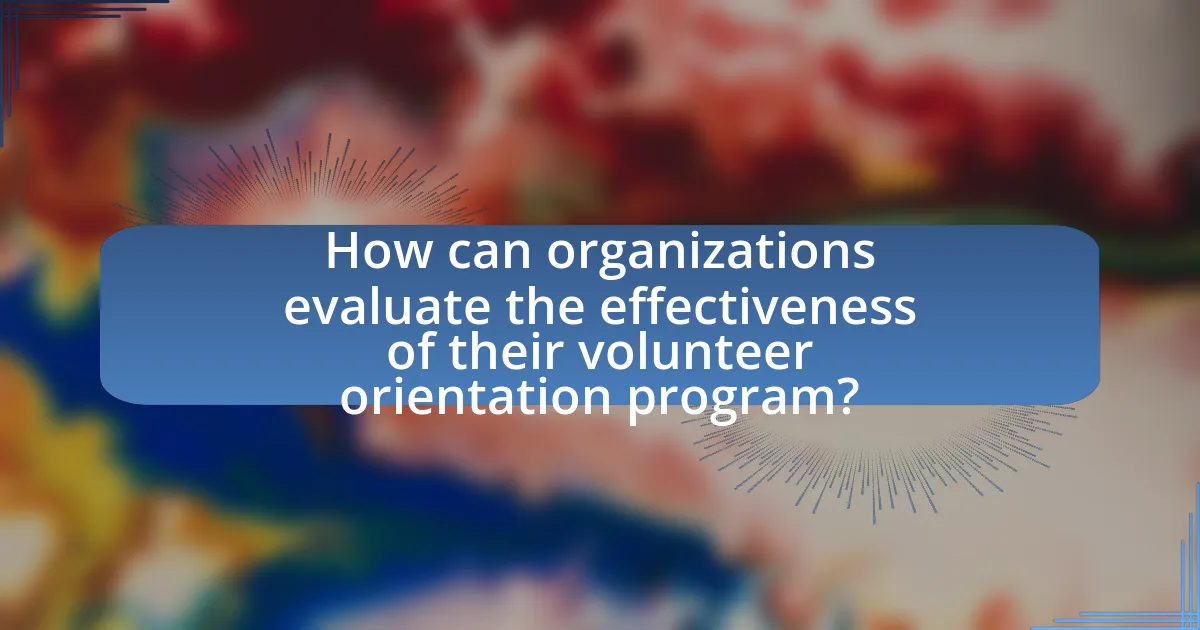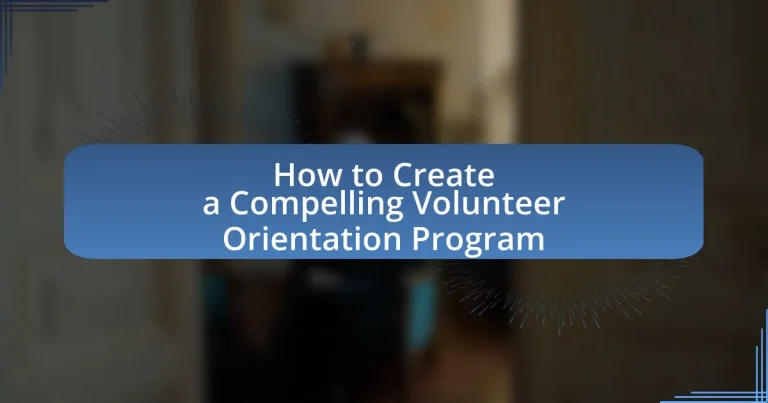A compelling volunteer orientation program is a structured process that effectively introduces new volunteers to an organization, its mission, and their specific roles. This article outlines the benefits of such programs, including enhanced volunteer engagement and retention, with research indicating that well-defined orientations can increase retention rates by up to 50%. Key objectives include familiarizing volunteers with the organization’s culture and providing essential training, while factors such as organizational culture and tailored content play a crucial role in the program’s success. The article also discusses effective training methods, evaluation metrics, and strategies for continuous improvement, emphasizing the importance of feedback and engagement in creating a positive volunteer experience.

What is a Compelling Volunteer Orientation Program?
A compelling volunteer orientation program is a structured process designed to effectively introduce new volunteers to an organization, its mission, and their specific roles. This program typically includes comprehensive training sessions, clear communication of expectations, and opportunities for engagement with existing team members. Research indicates that organizations with well-defined orientation programs experience higher volunteer retention rates, as evidenced by a study from the Corporation for National and Community Service, which found that effective onboarding can increase volunteer commitment by up to 50%.
How does a volunteer orientation program benefit organizations?
A volunteer orientation program benefits organizations by enhancing volunteer engagement and retention. By providing clear expectations, training, and support, organizations can ensure that volunteers feel valued and equipped to contribute effectively. Research indicates that organizations with structured orientation programs experience a 50% increase in volunteer retention rates, as volunteers are more likely to stay committed when they understand their roles and the organization’s mission. This structured approach not only fosters a sense of belonging but also improves overall organizational efficiency, as trained volunteers are more productive and aligned with the organization’s goals.
What are the key objectives of an effective orientation program?
The key objectives of an effective orientation program are to familiarize new volunteers with the organization’s mission, values, and culture, while also providing essential information about their roles and responsibilities. This foundational understanding enhances engagement and retention, as studies show that well-oriented volunteers are 50% more likely to remain active in their roles. Additionally, effective orientation programs aim to build relationships among volunteers and staff, fostering a sense of community and collaboration, which is crucial for a positive volunteer experience.
How does orientation impact volunteer retention rates?
Orientation significantly impacts volunteer retention rates by providing essential information, fostering connections, and enhancing engagement. A well-structured orientation program equips volunteers with the necessary skills and knowledge to perform their roles effectively, which increases their confidence and satisfaction. Research indicates that organizations with comprehensive orientation programs experience retention rates as high as 50% compared to those with minimal or no orientation, where retention can drop below 20%. This correlation highlights the importance of orientation in creating a supportive environment that encourages volunteers to remain committed to their roles.
Why is it important to tailor orientation programs to specific organizations?
Tailoring orientation programs to specific organizations is crucial because it ensures that the content aligns with the organization’s mission, values, and operational procedures. Customized orientation enhances the relevance of the information presented, making it more applicable to the volunteers’ roles and responsibilities. Research indicates that organizations with tailored onboarding processes experience a 50% greater new hire retention rate, as employees feel more connected and engaged when the orientation reflects the unique culture and expectations of the organization. This alignment fosters a sense of belonging and purpose among volunteers, ultimately leading to improved performance and satisfaction.
What factors should be considered when customizing an orientation program?
When customizing an orientation program, key factors to consider include the target audience’s demographics, the specific goals of the program, the organizational culture, and the resources available for implementation. Understanding the demographics, such as age, background, and experience levels of volunteers, allows for tailored content that resonates with participants. Defining clear goals ensures that the orientation meets both the needs of the organization and the volunteers. Additionally, aligning the program with the organizational culture fosters a sense of belonging and engagement. Finally, assessing available resources, including time, budget, and personnel, is crucial for creating a feasible and effective orientation program.
How can organizational culture influence the orientation process?
Organizational culture significantly influences the orientation process by shaping the values, behaviors, and expectations that new volunteers encounter. A strong organizational culture fosters a sense of belonging and alignment with the mission, which can enhance engagement and retention during orientation. For instance, organizations with a collaborative culture may emphasize teamwork and peer support in their orientation programs, leading to a more integrated experience for new volunteers. Research indicates that organizations with clear cultural values see a 30% increase in volunteer retention rates, demonstrating the impact of culture on the orientation process.

What are the essential components of a successful volunteer orientation program?
A successful volunteer orientation program includes clear communication of the organization’s mission, comprehensive training on roles and responsibilities, and an introduction to policies and procedures. Clear communication ensures that volunteers understand the purpose and goals of the organization, which fosters engagement and commitment. Comprehensive training equips volunteers with the necessary skills and knowledge to perform their tasks effectively, enhancing their confidence and performance. Introducing policies and procedures helps volunteers navigate the organizational structure and adhere to guidelines, promoting a safe and respectful environment. These components are essential for creating a positive and productive experience for both volunteers and the organization.
How should the content of the orientation be structured?
The content of the orientation should be structured in a clear, logical sequence that includes an introduction, organizational overview, role-specific training, policies and procedures, and a conclusion. This structure ensures that volunteers understand the mission and values of the organization, their specific responsibilities, and the guidelines they need to follow.
Research indicates that effective orientation programs enhance volunteer retention and satisfaction, as evidenced by a study published in the Journal of Volunteer Administration, which found that structured orientations lead to a 30% increase in volunteer engagement.
What topics should be covered in the orientation session?
The orientation session should cover the organization’s mission, values, and goals, as well as the roles and responsibilities of volunteers. Additionally, it should include training on policies and procedures, safety protocols, and communication expectations. Providing this information ensures that volunteers understand their contributions and the overall impact of their work, which is crucial for engagement and retention. Research indicates that effective orientation programs can increase volunteer satisfaction and commitment, leading to better organizational outcomes.
How can interactive elements enhance the orientation experience?
Interactive elements enhance the orientation experience by actively engaging participants, which improves retention of information and fosters a sense of community. Research indicates that experiential learning, such as simulations and hands-on activities, can increase knowledge retention by up to 75% compared to traditional lecture-based methods. Additionally, incorporating interactive elements like group discussions and role-playing encourages collaboration and builds relationships among volunteers, leading to a more cohesive team environment. This engagement not only makes the orientation more enjoyable but also ensures that volunteers feel more connected to the organization’s mission and values.
What role does training play in the orientation process?
Training is essential in the orientation process as it equips volunteers with the necessary skills and knowledge to perform their roles effectively. By providing structured training, organizations ensure that volunteers understand their responsibilities, the mission of the organization, and the specific tasks they will undertake. Research indicates that well-trained volunteers are more likely to feel confident and engaged, leading to higher retention rates and better overall performance. For instance, a study by the Corporation for National and Community Service found that organizations with comprehensive training programs reported a 50% increase in volunteer satisfaction and commitment.
How can training sessions be effectively integrated into the orientation?
Training sessions can be effectively integrated into the orientation by aligning them with the overall goals and objectives of the orientation program. This alignment ensures that new volunteers understand their roles and responsibilities from the outset. Incorporating interactive elements, such as hands-on activities or role-playing scenarios, enhances engagement and retention of information. Additionally, scheduling training sessions at strategic points during the orientation, such as immediately after introducing key concepts, allows for immediate application of knowledge. Research indicates that experiential learning increases retention rates by up to 75%, demonstrating the effectiveness of this approach.
What types of training methods are most effective for volunteers?
Interactive training methods, such as hands-on workshops and role-playing scenarios, are most effective for volunteers. These methods engage participants actively, allowing them to practice skills in real-life situations, which enhances retention and understanding. Research indicates that experiential learning, where volunteers learn by doing, significantly improves their confidence and competence in their roles. For instance, a study published in the Journal of Volunteer Administration found that volunteers who participated in interactive training reported a 30% increase in their ability to perform tasks compared to those who received traditional lecture-based training.

How can organizations evaluate the effectiveness of their volunteer orientation program?
Organizations can evaluate the effectiveness of their volunteer orientation program by utilizing feedback surveys, performance metrics, and retention rates. Feedback surveys administered to volunteers immediately after the orientation can provide insights into their understanding of the program and areas for improvement. Performance metrics, such as the completion of training modules and engagement levels during the orientation, can indicate how well the program prepares volunteers for their roles. Additionally, analyzing retention rates of volunteers over time can reveal the long-term impact of the orientation program on volunteer satisfaction and commitment. These methods collectively offer a comprehensive assessment of the program’s effectiveness.
What metrics should be used to assess the success of the program?
To assess the success of a volunteer orientation program, key metrics include participant satisfaction, retention rates, and engagement levels. Participant satisfaction can be measured through post-orientation surveys that gauge attendees’ perceptions of the program’s content and delivery. Retention rates indicate how many volunteers continue their involvement after the orientation, reflecting the program’s effectiveness in fostering commitment. Engagement levels can be assessed by tracking volunteer participation in subsequent activities and their feedback on the orientation experience. These metrics provide concrete evidence of the program’s impact on volunteer motivation and long-term involvement.
How can feedback from volunteers improve future orientation sessions?
Feedback from volunteers can significantly enhance future orientation sessions by identifying strengths and weaknesses in the current program. When volunteers provide insights on their experiences, organizers can pinpoint specific areas that require improvement, such as content clarity, engagement strategies, or logistical arrangements. For instance, a study by the Corporation for National and Community Service found that programs incorporating volunteer feedback saw a 30% increase in participant satisfaction and retention rates. This data underscores the importance of actively seeking and implementing volunteer suggestions to create a more effective and appealing orientation experience.
What tools can be used to gather and analyze feedback?
Surveys and feedback forms are effective tools to gather and analyze feedback. These tools can be implemented through platforms like SurveyMonkey, Google Forms, and Typeform, which allow users to create customized questionnaires that can be distributed to volunteers. Data collected through these surveys can be analyzed using built-in analytics features or exported to software like Excel or SPSS for more detailed analysis. Research indicates that structured feedback collection methods significantly improve the quality of insights gained, enabling organizations to make informed decisions about their volunteer programs.
How can organizations continuously improve their volunteer orientation programs?
Organizations can continuously improve their volunteer orientation programs by regularly soliciting feedback from volunteers and implementing changes based on that input. For instance, conducting surveys after each orientation session allows organizations to gather insights on what aspects were effective and which areas need enhancement. Research indicates that organizations that actively engage volunteers in the evaluation process see a 25% increase in volunteer retention rates, demonstrating the importance of adapting programs to meet volunteer needs. Additionally, incorporating best practices from successful programs, such as interactive training methods and mentorship opportunities, can further enhance the effectiveness of orientation sessions.
What best practices should be followed for ongoing program development?
Best practices for ongoing program development include regular evaluation, stakeholder feedback, and adaptive planning. Regular evaluation ensures that the program meets its objectives and identifies areas for improvement. Stakeholder feedback, including input from volunteers and community members, provides insights that can enhance program effectiveness. Adaptive planning allows for flexibility in response to changing needs and circumstances, ensuring the program remains relevant and impactful. Research shows that programs incorporating these practices are more successful in achieving their goals and sustaining volunteer engagement.
How can organizations stay updated with trends in volunteer management?
Organizations can stay updated with trends in volunteer management by actively engaging in professional networks and utilizing online resources. Participating in conferences, webinars, and workshops focused on volunteer management allows organizations to learn from experts and peers about the latest practices and technologies. Additionally, subscribing to relevant journals and newsletters, such as the “Journal of Volunteer Administration,” provides access to research findings and case studies that highlight emerging trends. Engaging with social media platforms and online forums dedicated to volunteerism also facilitates real-time discussions and insights into current challenges and innovations in the field.
What are some common challenges faced in creating a volunteer orientation program?
Common challenges faced in creating a volunteer orientation program include insufficient resources, lack of clear objectives, and difficulty in engaging volunteers. Insufficient resources can lead to inadequate training materials and support, which hampers the effectiveness of the program. Lack of clear objectives results in confusion regarding the program’s goals, making it hard for volunteers to understand their roles. Difficulty in engaging volunteers often stems from a one-size-fits-all approach, failing to address the diverse motivations and backgrounds of volunteers, which can lead to low retention rates.
How can organizations overcome resistance to change in orientation practices?
Organizations can overcome resistance to change in orientation practices by actively involving stakeholders in the change process. Engaging employees and volunteers in discussions about the changes fosters a sense of ownership and reduces apprehension. Research indicates that participation in decision-making can lead to a 30% increase in acceptance of new practices (Kotter, 1996). Additionally, providing clear communication about the benefits of the changes and offering training sessions can further alleviate concerns. Studies show that organizations that effectively communicate the rationale behind changes experience 50% less resistance (Armenakis & Bedeian, 1999). By implementing these strategies, organizations can successfully navigate resistance and enhance their orientation programs.
What strategies can be employed to engage volunteers during orientation?
To engage volunteers during orientation, interactive activities such as icebreakers, group discussions, and hands-on training sessions can be employed. These strategies foster a sense of community and encourage participation, making volunteers feel valued and connected from the outset. Research indicates that interactive orientations lead to higher retention rates, as volunteers are more likely to remain engaged when they actively participate in the learning process. For instance, a study by the Corporation for National and Community Service found that organizations utilizing interactive training methods reported a 30% increase in volunteer satisfaction compared to traditional lecture-based orientations.
What practical tips can enhance the volunteer orientation experience?
To enhance the volunteer orientation experience, organizations should implement interactive training sessions that engage volunteers actively. Engaging volunteers through role-playing scenarios or hands-on activities fosters better understanding and retention of information. Research indicates that experiential learning increases knowledge retention by up to 75%, compared to traditional lecture-based methods. Additionally, providing clear expectations and outlining the organization’s mission and values helps volunteers align their efforts with the organization’s goals, leading to increased satisfaction and commitment.


